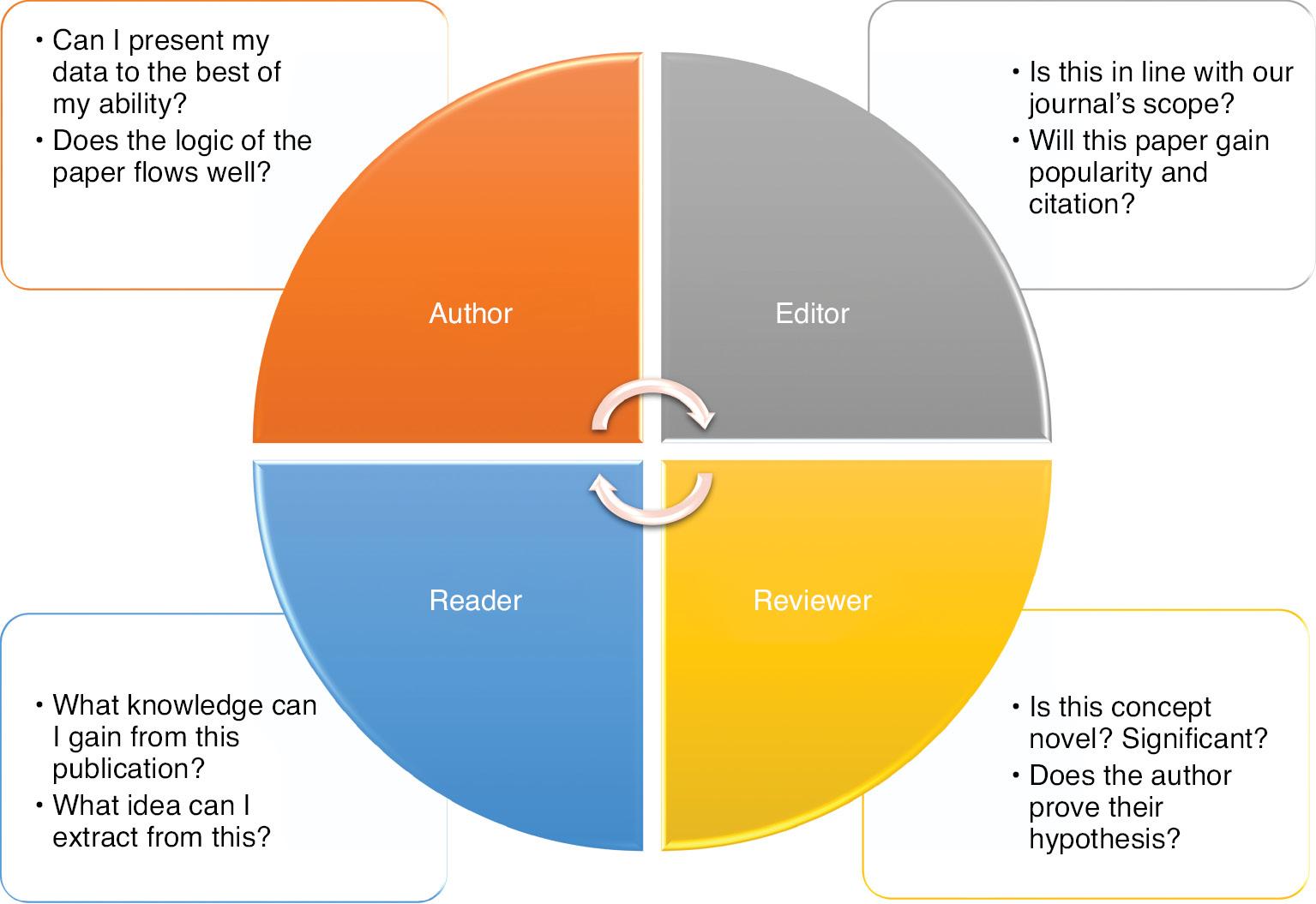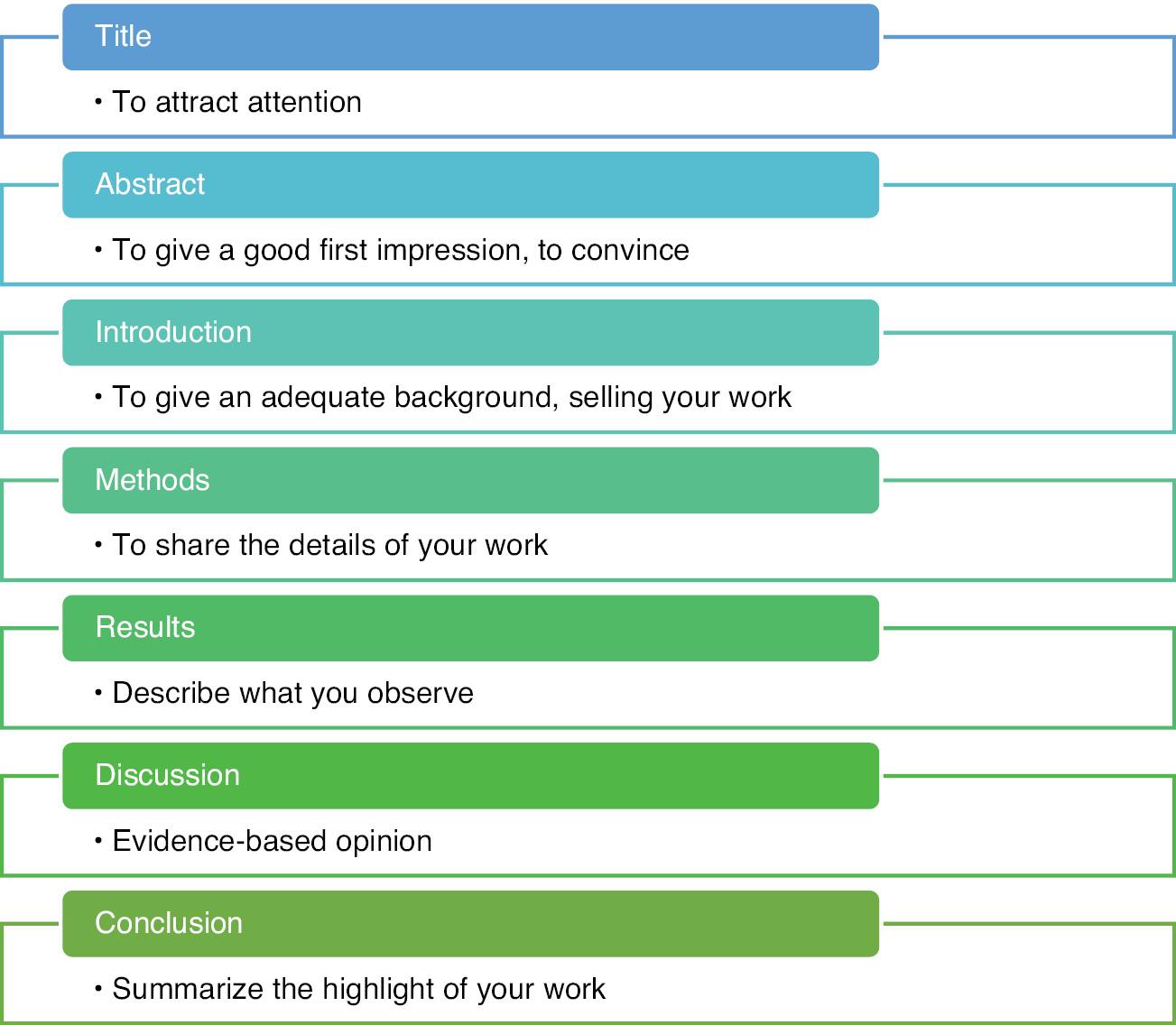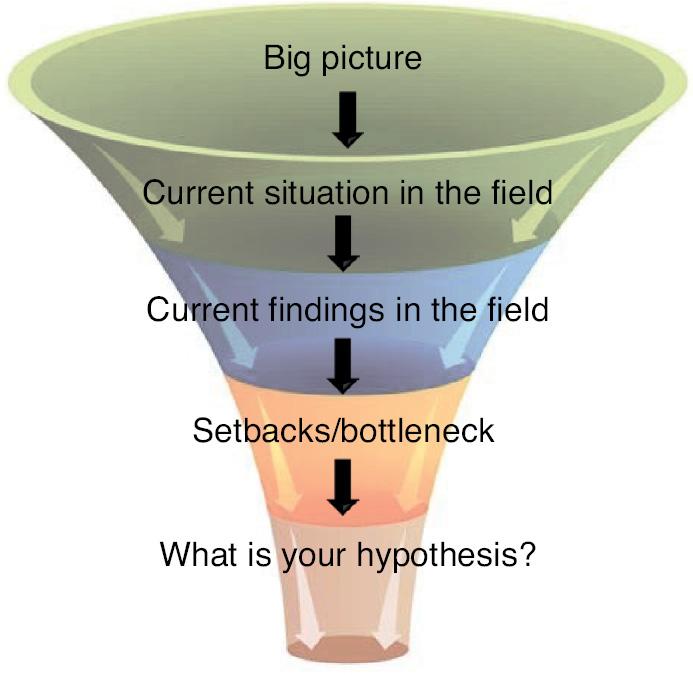Introduction
For non-native English speakers, a lack of command of the English language may hinder publishing scientific or academic articles, particularly among individuals from monolingual countries with lower English proficiency than that in bilingual or trilingual countries. Publishing in English-language journals is an important component of academicians’ and clinicians’ careers [1]. However, English writing is not an easy task. Writers must learn the differences between fiction and formal academic writing, and must have adequate knowledge of the use of specialized scientific and medical terms [2].
Furthermore, in writing original articles, authors should not write from only their viewpoint but instead should integrate all factors that might influence the final disposition of the article [3–5] ( Figure 1 ). An editor might judge an article according to whether it describes a topic of interest, and whether it would augment journal citations, thereby increasing views by readers and the journal’s impact factor. A reviewer might consider the depth, quality and amount of work done in the article, and whether the data presented meet the journal’s standards, whereas readers might be interested in the new information provided by the article.

Differing viewpoints of authors, editors, reviewers, and readers in assessing an original article. Authors should consider all factors that might lead to rejection of the article.
On the basis of our experience in giving more than 200 lectures in proper scientific writing methods, we summarize the important points of focus during manuscript writing. Because non-native English speakers may have difficulties in navigating the lengthy instructions given by various journals, we summarize and highlight crucial information necessary for authors to begin the academic writing process. Throughout this article, we detail the importance of each section of the manuscript and its purpose, while avoiding jargon and terms that may be unfamiliar to readers. We note that the information in this article is generally true; nevertheless, authors should always refer to the journal’s author guidelines for specific details during submission.
We hope that this article will help more non-native English speakers in their quest to write scientific or medical research articles, and to avoid unnecessary rejection from journal editors due to insufficient skills in writing.
Types of articles
Authors should first have clarity regarding the article type. All journals indicate the different manuscript types in their authors’ guidelines. Specialized journals accept only certain types of articles. For example, the Nature Reviews journals accept only review articles, whereas Nature Communications accepts only communications and brief reports. We will also delve into the importance and uniqueness of each article type in an upcoming article. Features of the various article types are summarized in Table 1 . We will also describe the purposes and types of articles in upcoming articles.
Summary of Various Types of Articles and their Formats, Respectively
| Article Type | Original Data | Abstract | Introduction | Methods | Results | Discussion | Conclusion | Peer Review |
|---|---|---|---|---|---|---|---|---|
| Editorial | No | X | / | X | X | / | / | / |
| Editorial Commentary | No | X | / | X | X | / | / | / |
| Original Article | Yes | / | / | / | / | / | / | / |
| Review | No | / | / | X | X | X | / | / |
| Mini Review | No | / | / | X | X | X | / | / |
| Perspective/Opinion | No | X | / | X | X | / | / | / |
| Letter to the Editor | No | X | X | X | X | / | / | X |
| Case Report | Yes | / | / | / | / | / | / | / |
| Technical Note | Depends | Depends | / | / | / | / | / | / |
| Brief Report/Communication | Yes | / | / | / | / | / | / | / |
| News and Views | No | X | / | X | X | X | / | X |
| Commentary | No | / | / | X | X | / | / | / |
Each article type represents a different level and perspective of writing. For original articles, communications, and brief reports, authors should report original data and present new findings that could help advance their field. For reviews, authors should summarize recent findings on a particular topic of interest while providing their insights, whereas editorials/commentaries/opinions/perspectives should be geared toward providing a short overview and outlook for a particular subject. In this article, we focus on only the systematic analysis involved in writing an original article.
Sequence of manuscript writing
Although the first section of an article is the title, followed by abstract and keywords, the best writing technique follows the steps below.
Prepare all figures and tables: Authors must carefully prepare all figures and tables. Only when all data have been systematically arranged can the logical flow of the article be clearly understood. Authors may confer with peers or the corresponding author to gain feedback on whether the logical flow of the storyline is clear. Data arrangement should be flexible and should revolve around the core storyline.
Write the methods: Authors should clearly describe all details for all experiments conducted in the article. Therefore, they may choose to write the methods before other sections in the article. We encourage authors to start writing the methods as early as the beginning of their experiments, to maintain the academic integrity and accuracy of the descriptions of their work.
Write the results: After all figures and tables are ready, authors can start to describe their data in detail. Authors should be careful to describe all data included in the article.
Write the discussion: The discussion and results sections are sometimes combined; therefore, authors should read the authors’ guidelines carefully to determine whether the discussion section should be written separately.
Write a clear conclusion: The conclusion is a concise summary including the highlights, novelty, and future impact of the study.
Write the introduction: Authors should provide a clear portrait of the general background of the article. The introduction should include compelling background indicating the importance of the research.
Write the abstract: The abstract is the most important section, and it gives readers a first impression of the article.
Think of a title: The title should be concise and descriptive, and sufficiently informative to provide a general picture of the work.
Select keywords: These four to six words are crucial for indexing, citation, and search-engine prioritization of the article.
Write the acknowledgments: Proper acknowledgement is important, particularly regarding the funding that supported the study.
Details for writing each section of an article
Each section of an article is as important as the next. Therefore, authors should not be biased in prioritizing one section over another. One take home message for each section is described in Figure 2 .
Title
The main purpose of a title is to attract readers’ attention and encourage them to read the article. A good title tends to be general yet sufficiently specific for readers to grasp the concept of the article [6]. Writers with a solid command of English may choose to use metaphors, proverbs, paradoxes, or abbreviation in writing the title, for example, “To die or not to die,” “Turning friends to foe,” or “Killing two birds with one stone: a multi-modal imaging system.” One common mistake is the inclusion of lengthy descriptions of details in the title.
Key points:
Abstract
The abstract can be considered the “cover letter” of the article. It is a paragraph from which readers can obtain crucial information regarding the article. The abstract also provides a first impression of the article, on the basis of which the editor and reviewer decide on whether the article is worthy of further reading. Authors should always refer to previous publications in the target journal to determine the format of choice. Some journals prefer a combined form of abstract, where the background, objective, main results and conclusions are given in one paragraph, whereas others prefer a separate, individually listed abstract, with the background, objective, main results and conclusions are given as an individual sub-headings. Again, it is not the question of being in the right or wrong, rather, it is the question of getting the correct format to be in line with the journal’s request and formatting. Below, we summarize several key questions that authors should answer to write a logical abstract.
Key questions:
What is the background of this study?
What has been done by others previously what has not been explored in this topic?
What is the bottleneck/unresolved question in this topic?
What did you plan to do?
What was your aim, and how did you seek to answer the research question?
What did you observe during the study?
What is your conclusion? What will the impact of this study be on the general public, patients, or advancement of the field?
Keywords
Keywords are important for journal indexing, and provide an easy way for readers to search for an article. Most, if not all, online search engines rely heavily on keyword matching during article searching. An article usually has four to six words chosen as the keywords. Suggestions for keywords are as follows:
Introduction
The introduction can simply be considered to “set the scene.” Have you ever wondered how you can recognize a certain movie from a simple flash of a scene? That is because it has been made known to you that that scene belongs to that movie. By providing a good introduction to your storyline, you can promote readers’ interest in reading subsequent parts of the article. Another way of describing an introduction is selling a story to readers. The introduction is where authors answer the question “why?” Authors should present the importance and impact of the article in a smooth and logical manner to readers. Several key points regarding introductions are as follows ( Figure 3 ).
Key points:
Use the funnel system to introduce a general picture of the article, followed by current research bottlenecks, and the study aims for solving this problem.
Respect previous publications even when mentioning the flaws of previous work, and do not include personal bias.
Ensure that most, if not all, keywords are introduced in detail in the introduction.
Ensure that a clear link exists among the introduction, bottlenecks, and study aims.
Do not introduce new findings (highlights of the article) in the introduction. This information should be included as highlights in the discussion.
Materials and methods
The methods section is usually divided into two parts: materials and methods. All materials, solvents, biologics, chemicals, antibodies, cell lines, and animals should be listed in the materials section. All data presented in the main manuscript should be described in the methods section, in order of appearance in the results section. The methods section answers the question of “how?” to help readers understand the technical aspects of the research. The methods section should be written to allow for easy replication of experiments, including adequate information regarding the materials used. A common mistake is simply run-through this section, or copying and pasting descriptions of experiments from previous publications. Doing so usually results in a high text duplication percentage, and might consequently lead to accusations of plagiarism and academic misconduct.
The three main components of the methods are as follows:
Results
In the results section, authors guides readers through their data specifically and sequentially. Therefore, the quality of images and data in the results section is crucial for the final representation. Authors should ensure that all figures, tables, and schematic diagrams have been prepared in the best way possible. Authors should know when to present data as a table, figure, graph, or another format. Tables are used when multiple data are involved (and are always included in clinical articles). Figures are used to visualize significant differences among small numbers of groups, whereas graphs are used to show numerical trends for a given topic. Authors should weigh the value of adding tables, figures, or graphs in their results, and should not include them if the data can be easily described within a few sentences. Authors should never omit an explanation of a data and then later provide an explanation. A simple presentation would be to describe Figure 1 before explaining Figure 2 . The following key points in the results section may be beneficial to authors.
Key points:
Describe only what you observe. Do not give your opinions on the reasons for the results.
Guide readers to follow your logic by placing important data in figures (for example, percentages or P values).
Avoid redundancy by removing duplicate images. Try to use statistical analysis to create quantitative data.
Increase ease of reading by using a consistent font size and type, and figure size, and minimize errors in figures.
Discussion
The discussion section provides “evidence-based opinions.” Authors are entitled to their own opinions regarding their own articles. However, authors should note that opinions based solely on experience are not justifiable. Evidence-based opinion refers to other publications supporting the basis of the results. Therefore, a literature review is crucial for obtaining information regarding which may be closely associated with your article. When writing the discussion, authors should provide a short summary or a general background of the study, then list three or four highlights of the article. The following paragraphs should discuss each highlight individually. These highlights are the same result highlights described in the abstract. Here, authors should clearly differentiate between “strong” and “weak” results. Strong results are new and interesting, and may possibly be a highlight of the article, whereas weak results are purely observational and supplementary—they are important to support an argument, but are not new and should not be prioritized in the discussion.
Key points to consider when choosing highlights are as follows:
This is an entirely new observation.
No one has obtained this result in this field.
The link between protein A and B has never been demonstrated to date.
Is this a new therapeutic intervention/drug/treatment modality?
When discussing highlights, authors should state the highlight, followed by evidence from another publication supporting the current data. If contradictions exist between the current data and previous publications, authors should determine and clearly describe the reason for the contradiction in the discussion section. Some reasons include differences in timepoints, cell lines, animal models, and study populations. For clinical articles, the discussion should end with a paragraph describing study limitations. What was lacking in the article that the authors might improve upon in future studies? This section provides editors and reviewers with a preview of upcoming work and assurance that the authors know exactly what to do to improve the current study.
Conclusion
The conclusion summarizes the essence of the article. The conclusion is usually presented in fewer than ten sentences, in a concise yet informative paragraph including the background, summary, highlights and future prospects of the study. Authors should discuss their hopes for future work, e.g., development of new drugs or therapeutic modalities, or a marked change in how a certain topic is perceived. Some journals do not request a separate conclusion section but instead combine the discussion and conclusion into a longer section. Therefore, authors should carefully read the authors’ guidelines to obtain specific instructions when writing an article.
Last words
Although academic writing is scientific and logical, it is also an art. Articles should be carefully crafted into beautiful pieces to gain the approval of editors, reviewers and readers alike [7]. Communicating in words may difficult and frustrating at times, particularly for writers whose first language is not English. However, with proper guidance and timely instructions, non-native English speakers should be able to fluently express their thoughts in words, share their hard work with the international community, and build a close-knit scientific community.


